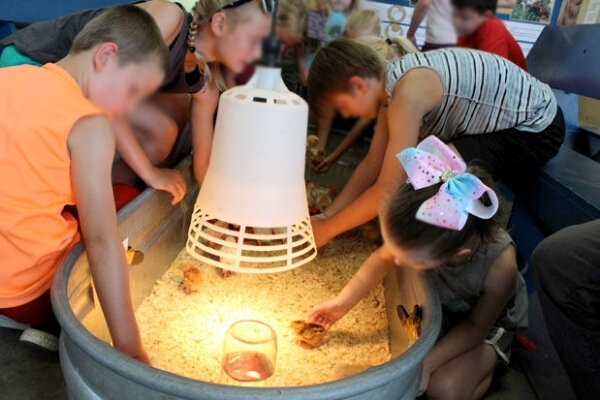
Petting Zoos
Petting zoos are displays that exhibit a range of baby animals for children to pet and feed. Unfortunately, while this may seem like a harmless activity, there are many welfare issues associated with the animals in petting zoos that tend to go unnoticed and unseen.
“[W]e have this fundamental responsibility to not take advantage” of animals who have no control over whether or not they live with humans.”
The Industry
Baby animals can be exhibited in pens at shopping centres, agricultural shows, fairs, parties, educational institutions, or for filming and photo shoots [1 PDF]. The most common species used in petting zoos are rabbits, guinea pigs, chickens, ducks, lambs, goats, and piglets.
Standards and Welfare Issues
Enclosures
According to the NSW standards, an animal must be given shelter from loud noise. This, however, is essentially impossible when a mobile establishment is set up at a shopping centre, agricultural show, fair or party, particularly where children and music are present. The standards provide no minimum requirement of space for the animals [1 PDF].
Time
An animal may be exhibited at any one mobile establishment continuously for 14 days. Any exhibitions exceeding this must be approved. While animals should be taken to an off-display establishment at night, carers can apply for an exemption to this. The standards state that animals should be given a refuge area (an area away from being touched by public), however, does not set a maximum time limit for being displayed each day. This means animals can legally be handled by the public for the entirety of an event [1 PDF].
Transport
Some petting zoos move around to various locations for kids parties or carnivals. This is stressful for the young animals, as they do not have the comfort of their mothers and are repeatedly exposed to unfamiliar environments [2 PDF].
Stress and injuries
Baby animals rely on their mothers for guidance and protection. In their absence, they experience extreme stress and fear. This is exacerbated by the fact that the children are a potential threat to them, even if unintentional [3]. Children are unaware of their bodies in terms of spatial awareness, and have not developed the understanding of being gentle. Children can also be loud, which can frighten the animals. Against their will, the baby animals are repeatedly picked up, held, patted, chased, and excitedly yelled at by children.
Baby chicks and ducklings often jump out of kids’ hands out of fear, which can result in injuries to their delicate bodies. They can also be accidentally trampled and crushed.
As they can also be on display in the same mobile establishment for 14 days at a time, their stress is continuous [[1 PDF], 4].
Breeding Cycle and Life After the Petting Zoo
Petting zoos only display young and “cute” animals, meaning they facilitate a never-ending cycle of breeding, separation, abandonment, and premature death. Exhibitors breed or acquire young animals, who are prematurely taken from their mothers, to be displayed to the public. As they grow older, they are ‘retired’, which often means slaughtered and replaced by baby animals.
As the animals grow, they start to become more difficult to handle and in some cases, less tolerant towards the kids. As a result, they are replaced by younger animals, and may be grown out and sold for slaughter or to other farms.
Health Issues
What can you do?
While people wish to educate and expose their children to animals and nature, baby animals should never be treated as inanimate, replaceable objects. These facilities do not provide animals with the love and care they deserve, nor do they teach children that animals deserve respect, space, and the ability to live in their natural setting with their family or community.
As parents or carers, we hold the power to end the suffering of animals in the petting zoo industry. Without our money, these facilities, events, activities and would simply cease to exist, ending the breeding cycle and freeing the animals from a lifetime of stress and misery.
The good news is, there are so many activities we can do instead, for entertainment, exposure to nature, or to teach our children about animals.






